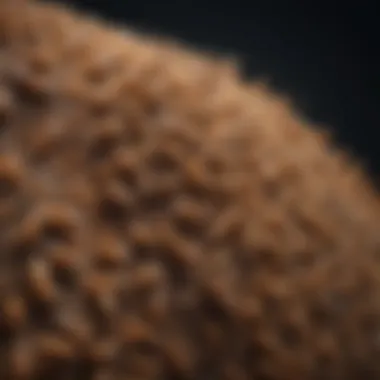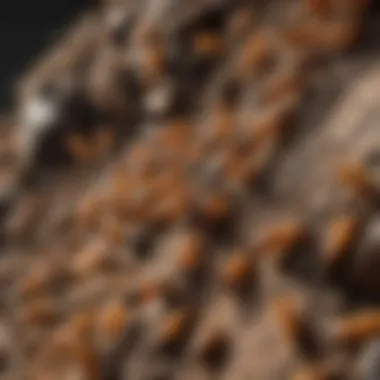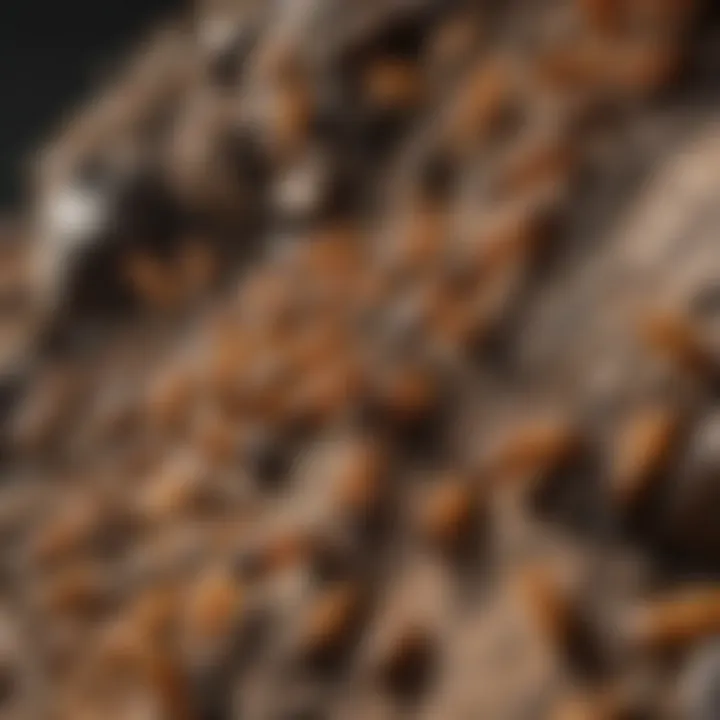Understanding Termites: Biology and Ecology Insights


Intro
Termites are often misunderstood as simple pests that cause damage to wooden structures. However, their biological complexity and ecological significance extend far beyond this reputation. In various ecosystems across the globe, termites play pivotal roles that contribute to soil health, nutrient cycling, and even carbon sequestration. This article intends to unravel the multifaceted world of termites, shedding light on their biology, behavior, and ecological interactions. Understanding these creatures requires a closer examination of their life cycles, the different species that inhabit diverse environments, and the implications of their activities.
Recent Advances
Latest Discoveries
Recent studies have unveiled intriguing details regarding termite social structures and their communication methods. Researchers have discovered that termites utilize pheromones for various purposes, including alarm signaling and food sourcing. These chemical signals enable colonies to collaborate effectively when faced with threats or opportunities.
Another notable advancement involves the genetic study of termites. Scientists have sequenced the genomes of several termite species, offering insights into their adaptability and evolutionary history. These genome studies have revealed specific genes involved in lignocellulose digestion—an ability crucial for breaking down tough plant materials. This capability not only influences their behavior but also their ecological roles.
Technological Innovations
Innovations in technology have furthered our understanding of termite behavior and ecology. For example, the use of remote sensing technology allows scientists to monitor termite populations and their impact on the environments. This technology can provide valuable data on how termites modify their habitats, which in turn affects other species within the ecosystem.
Moreover, molecular techniques like CRISPR are being explored to study gene functions in termites, opening new pathways for biological research that were previously unfeasible.
"Termites are not just destructive insects but rather crucial players in their ecosystems, influencing many ecological processes."
Methodology
Research Design
To study termites comprehensively, a multi-faceted approach is essential. Often, researchers employ observational studies combined with experimental methods to understand termite behavior. This combination provides a holistic view of how termites interact with their environment and other species. In many cases, field studies are conducted alongside controlled experiments in laboratories to explain findings and theorize about termite ecology.
Data Collection Techniques
Collecting data on termites involves several methods. Scientists may set up traps to capture termites from various species. This data helps in understanding their population dynamics and feeding patterns. Additionally, soil samples can be collected to measure microbial activity, which is influenced by termite activity. These samples offer insights into how termites contribute to nutrient cycling in the soil.
Foreword to Termites
Termites are often misunderstood and regarded merely as pests. However, their role in nature goes beyond destruction. This section aims to clarify the significance of termites in ecosystems and their taxonomy, providing foundational knowledge essential for understanding their biological insights and ecological impact.
Significance in Ecosystems
Termites are crucial players in many ecosystems. They contribute to soil health and nutrient cycling, enhancing soil aeration and promoting plant growth. Their feeding habits break down tough plant fibers, leading to the decomposition of organic materials. This process recycles nutrients back into the soil, which is important for overall ecosystem functionality. By creating tunnels in the soil, they facilitate water infiltration and increase oxygen levels, benefiting other organisms living in the soil.
Moreover, termites serve as food for many species, including birds, mammals, and reptiles. Hence, they maintain the balance in food webs, illustrating their significance in various ecological settings.
Overview of Taxonomy
Understanding termite taxonomy is essential for identifying various species and their ecological roles. Termites belong to the order Blattodea, which also includes cockroaches. They are generally classified into three main families: Rhinotermitidae, Termitidae, and Kalotermitidae. Within these families, there are numerous species that exhibit diverse behaviors and adaptations.
Taxonomy helps researchers categorize termites based on morphological features and genetic studies. These classifications provide insights into evolutionary relationships, which reveal how termites have adapted to different environments over time. For instance, some species are more adept at breaking down lignin and cellulose, while others focus on decomposing leaf litter.
By exploring termite taxonomy, one can appreciate the complexity and variety among species, helping to understand their roles in ecosystems better.
Biological Characteristics of Termites
Understanding the biological characteristics of termites is crucial for a comprehensive grasp of their role in the ecosystem and their interactions with humans. These characteristics provide insights into how termites function, thrive, and impact the environment.
In this section, we will explore essential aspects such as the anatomy and morphology, life cycle stages, and physiological adaptations of termites. Each of these elements reveals how termites have evolved to become a significant part of the ecosystem.
Anatomy and Morphology
Termites exhibit unique anatomical features that differentiate them from other insects. Their body structure is divided into three main regions: the head, thorax, and abdomen. The head houses crucial organs such as mandibles, which are specialized for chewing wood and plant material. This is essential for their diet, as termites primarily feed on cellulose found in wood.
The thorax consists of three segments, each bearing legs. Termite legs are adapted for digging and climbing, reflecting their ability to navigate complex environments. The abdomen is where most of the vital functions occur, including digestion and reproduction.
A noteworthy aspect of termite anatomy is the presence of symbiotic microorganisms in their guts, enabling them to break down cellulose effectively. This symbiosis is integral, as it aids in nutrient acquisition. Overall, the anatomical features of termites are adapted for their specific ecological roles, making them effective decomposers.
Life Cycle Stages
The life cycle of termites consists of several stages: egg, nymph, and adult.
- Egg Stage: The queen lays a significant number of eggs, which can amount to thousands in a single day. This stage is vital for colony expansion.
- Nymph Stage: After hatching, nymphs resemble adults but are smaller and lack fully developed wings. They undergo multiple molts, gradually developing into mature forms. Nymphs also have the potential to become soldiers or reproductive individuals, depending on colony needs.
- Adult Stage: Adult termites can be divided into three castes: workers, soldiers, and reproductives (kings and queens). Each caste has specific roles contributing to the colony’s survival. Workers are responsible for foraging and nest maintenance, soldiers protect the colony, and reproductives focus on mating and egg production.


This complex life cycle illustrates termites' adaptability and efficiency within their habitats.
Physiological Adaptations
Termites have several physiological adaptations that enable them to thrive in diverse environments. These adaptations include:
- Digestive System: Termites possess a unique digestive system that enhances their ability to process cellulose. The presence of protozoa and bacteria in their intestines is crucial, allowing them to digest plant materials that would be otherwise indigestible.
- Social Physiology: Termites communicate through a complex system involving pheromones and tactile signals. This allows them to coordinate activities within the colony, ensuring effective foraging and colony defense.
- Temperature Regulation: Some termite species have developed ways to regulate internal temperature, enabling them to tolerate varying climatic conditions. This adaptation helps in maintaining their colony’s efficacy even in extreme environments.
These physiological traits illustrate the intricacies of termite biology and highlight their evolutionary adaptations for survival.
Understanding the biological characteristics of termites showcases their complex physiology and social structures, contributing to their vital ecological roles.
In summary, the biological characteristics of termites, from anatomy to life cycles and physiological adaptations, underline their importance in both natural ecosystems and human contexts. These insights not only reveal the uniqueness of termites but also stress their enduring influence on ecological health.
Social Structure and Behavior
The social structure and behavior of termites represent a fascinating aspect of their complex biology. Understanding these elements is crucial as they reveal the intricate organization within colonies and how individual roles contribute to the survival of the group. Termites are social insects, living in colonies that can range from a few dozen individuals to millions. Each colony functions as a unified entity yet relies heavily on specialized castes to perform specific tasks. This specialization is beneficial in promoting efficiency and adapting to their ecological roles.
Castes within Termite Colonies
Termite colonies consist of various castes, primarily divided into workers, soldiers, and reproductive individuals. Each caste has distinct responsibilities vital to the colony's survival and prosperity.
- Workers: These termites make up the bulk of the colony. Their duties involve foraging for food, caring for the young, and maintaining the nest. They are responsible for building and repairing the intricate tunnels of the colony. This caste plays a crucial role in ensuring that the colony operates smoothly.
- Soldiers: Soldier termites defend the colony from predators and other threats. They possess strong mandibles and larger bodies than workers, allowing them to protect their kin effectively. Although they do not participate in foraging or reproduction, their presence is essential for colony survival.
- Reproductives: This caste consists of the king and queen, responsible for the colony's growth and reproduction. These individuals can produce thousands of eggs daily, ensuring a stable population. Their role is significant, as without them, a colony cannot sustain itself.
This caste system signifies a highly organized structure that underpins the functionality and resilience of termite colonies. The division of labor allows for greater specialization, leading to a more effective colony.
Communication Mechanisms
Communication among termites plays a vital role in maintaining colony dynamics. These insects rely heavily on pheromones, which are chemical signals that convey information about food sources, danger, and reproductive status. The ability to communicate effectively allows for coordination and teamwork, which is essential for the survival of the colony.
- Pheromonal Signals: Various scents serve different purposes. For example, a trail pheromone can help workers locate food sources, while alarm pheromones signal danger, prompting soldiers to respond. This chemical communication ensures that termites can work cohesively as a unit.
- Tactile and Vibrational Signals: In addition to pheromones, termites utilize physical contact and vibrations to communicate. Workers may tap on the walls of the nest to send signals, contributing to both information relay and reinforcement of social bonds.
Effective communication systems within termite colonies are critical for their social structure and overall survival. Given their complex interactions, these mechanisms facilitate the day-to-day functioning of the colony.
Foraging and Feeding Behavior
Foraging and feeding behavior are central to the ecological role of termites. Their diet primarily consists of cellulose, which they obtain from wood, leaf litter, and decaying plant matter. This feeding behavior has significant implications for nutrient cycling and decomposition processes in their ecosystems.
- Collective Foraging: Termites often forage in groups, increasing efficiency and success in locating food sources. The workers will communicate findings through pheromones, ensuring that other members of the colony can benefit from discovered resources.
- Digestive Adaptations: Termites possess unique digestive systems, aided by symbiotic microorganisms in their guts that help break down cellulose. This relationship allows termites to access nutrients that many other organisms cannot exploit.
The foraging behavior showcases the ecological importance of termites, as they contribute to soil health and nutrient cycling in their habitats. Their collective efforts not only sustain their colonies but also support broader ecosystem functions.
Understanding the social structure and behavior of termites highlights their complexity and importance within ecosystems. Their specialized roles, communication techniques, and feeding habits reflect a sophisticated organization that underscores their ecological significance.
Ecological Roles of Termites
Termites play a significant role in sustaining ecosystems, influencing various biological and chemical processes. Their activities contribute to enhancing soil health, promoting nutrient cycling, and supporting diverse plant and animal communities. Understanding these ecological roles provides insight into their importance beyond mere pests.
Soil Aeration and Fertility
Termites are crucial in soil aeration. By constructing extensive tunnel systems, they facilitate air and water flow within the soil. This aeration is essential for root development and microbial activity, enhancing overall soil fertility.
- Nutrient Distribution: The tunnels that termites create mix organic material into the soil, improving nutrient distribution. This activity helps in decomposing plant matter, which adds vitamins and minerals to the soil.
- Improved Water Retention: The structures of termite mounds trap moisture, allowing the soil to retain water longer. This has benefits during dry seasons, aiding the survival of many plant species.
Contributions to Decomposition Processes
Termites play a vital role in decomposition. They consume dead wood, leaf litter, and other organic material, breaking it down and recycling it back into the ecosystem. This process contributes significantly to nutrient cycling.
- Efficient Breakdown: Termites digest cellulose through symbiotic relationships with microorganisms in their guts. This allows them to efficiently break down tough plant materials that many organisms cannot.
- Enhanced Biodiversity: By decomposing organic materials, termites help create a habitat for other microorganisms and soil-dwelling creatures. This encourages a more diverse ecosystem.
Interactions with Other Species
Termites have complex interactions with many other species, playing both a direct and indirect role in their environment.
- Mutualism: Some birds, such as the Greater Vasa Parrot, depend on termites for food. In turn, they help control the termite populations, maintaining a balance in the ecosystem.
- Food Source: Many predators, including mammals and reptiles, rely on termites as a food source. This shows their role in the broader food web, influencing the population dynamics of other species.
"Termites act as ecosystem engineers, creating habitats that support diverse life forms while also facilitating vital ecological processes."


Termite Species Diversity
Termite species diversity plays a crucial role in understanding the biological and ecological impact of these insects. There are more than 3,000 recognized species of termites, each having unique characteristics and roles in their respective ecosystems. This diversity contributes significantly to their ecological functions, interactions with other organisms, and responses to environmental changes. By exploring termite species diversity, we can gain insights into their adaptation strategies, habitat requirements, and their intricate relationships with their environments.
The variety of termite species illustrates the adaptability of these insects. They inhabit different ecological niches ranging from tropical rainforests to arid deserts. Understanding the preferences and requirements of various species can assist in conservation efforts. These insights also aid in agriculture and structural practices, particularly in preventing and controlling termite infestations.
Classification of Main Families
Termite classification is generally divided into three main families: Reticulitermitidae, Termitidae, and Kalotermitidae. Each family holds distinct characteristics.
- Reticulitermitidae: Known as the subterranean termites, they are the primary pests causing structural damage in buildings. They form large colonies and create extensive underground tunnels.
- Termitidae: This is the most diverse family, consisting of termites which build mounds and live in trees. They play vital roles in nutrient recycling and soil aeration. Their social structure is complex, exhibiting significant variation in caste and behavior.
- Kalotermitidae: Termed as drywood termites, these species usually live in dry wood within structures. Their feeding habits often cause damage over an extended period, making detection difficult.
Habitat Preferences of Various Species
Termite habitat preferences vary notably among species. Factors such as moisture, temperature, and food availability influence these preferences. Each species has adapted to thrive in specific environments.
- Moisture-rich habitats: Species like Reticulitermes flavipes thrive in areas with abundant moisture and are often found in soil near decomposing wood.
- Dry habitats: The Kalotermes genus is more common in drier regions, where they can inhabit old wood in buildings or live trees without requiring much moisture.
- Forest ecosystems: Termites like Nasutitermes species prefer forest environments and contribute significantly to the decomposition of organic matter, thus enhancing nutrient cycling.
Notable Species and Their Characteristics
Several termite species exhibit distinct characteristics that shape their roles within ecosystems.
- Eastern Subterranean Termite (Reticulitermes flavipes): This species is notorious for its destructive impact on wooden structures. It forms large colonies and is the most common termite pest in the United States.
- Royal Termite (Macrotermes bellicosus): Found in Africa, this species builds large, complex nests that can house millions. They are essential for nutrient cycling in their environment.
- Drywood Termite (Incisitermes snyderi): This species is known for its ability to thrive in dry wood. They do not require contact with soil, making them unique among termites. Their infestations can often go unnoticed until significant damage has occurred.
Understanding these diverse species not only aids in termite control but also highlights their ecological importance and adaptability.
Through this overview, we recognize that termite species diversity is critical. It combines various aspects such as habitat preferences, classification challenges, and notable species findings. A better understanding of this diversity can lead to more effective management and conservation strategies.
Termite Damage and Human Conflict
Termite damage poses significant challenges for homeowners, business owners, and cultural perceptions. Understanding the nature of termite infestations is essential for developing effective strategies to mitigate their impact. The destructive potential of termites is well-documented, but their ecological roles are often overlooked. This section will dissect the complexities of termite damage and how it intertwines with human activities and perceptions.
Assessment of Structural Damage
Termites can cause extensive structural damage to buildings. They tend to feed on wood, paper, and other cellulose materials, leading to weakened foundations, beams, and furniture. Areas with high moisture are particularly susceptible to infestation.
In urban settings, a few signs can indicate termite presence:
- Mud tubes on exterior walls
- Frass or wood dust beneath furniture
- Hollow sounds when tapping on wooden structures
Regular inspections are crucial to assess potential damage. Often, the damage is not immediately visible. Hence, it is advisable to employ professionals for detailed evaluations.
"By the time that damage becomes visible, termites may have caused significant destruction."
This statement underscores the importance of proactive measures. Ignoring early signs can lead to costly repairs or in some cases, complete structural failure.
Economic Impact of Infestations
The economic ramifications of termite infestations are profound. In the United States alone, the impact is estimated at upwards of five billion dollars annually. This figure encompasses cost for damage repair, treatments, and preventative measures. The implications are not restricted to individual homeowners but also affect builders, landlords, and real estate markets.
Some economic factors include:
- Repair costs are often substantial, affecting personal finances.
- Insurance premiums may rise as a consequence of increased claims related to termite damage.
- Property values can decrease with known infestations, creating a negative ripple effect on real estate markets.
Businesses, particularly those in hospitality and food service, need to be alert. A single case of a termite infestation can ruin reputation, harm client relationships, and lead to loss of revenue.
Cultural Perceptions of Termites
Perceptions of termites are complex and often contradictory. Many view them primarily as pests, associated with destruction and economic loss. Conversely, some cultures recognize their environmental contributions. Some African communities actively collect termites for food, appreciating their high protein content.
In various cultures, termites symbolize resilience or even transformation. However, these positive aspects tend to be overshadowed by the damages they cause. Education plays a pivotal role in reshaping negative perceptions. Awareness can lead to a more balanced view, recognizing their ecological value while addressing the destructive potential.
In summary, termite damage encompasses a range of implications for structures, economies, and cultural perceptions. Addressing these concerns requires a multifaceted approach that considers both the challenges presented by termite infestations and their ecological significance.
Strategies for Termite Control
In addressing the challenges posed by termites, it is essential to develop effective strategies for their control. This segment of the article examines various methods that can be employed to prevent and mitigate termite infestations. Controlling termite populations not only protects structures but also contributes to agricultural sustainability, making it a significant topic.


The management of termites must consider specific elements such as the understanding of their behavior, habitat preferences, and life cycle. Effective control strategies integrate methods that are both environmentally friendly and economically viable. This section outlines successful approaches that have shown efficacy in reducing termite activity, thus protecting vital resources.
Preventative Measures in Construction
Preventative measures during the construction phase are critical in reducing the risk of termite infestations. Proper planning and material selection can significantly lower the likelihood of termites causing damage.
When building, consider the following actions:
- Use of Termite-Resistant Materials: Selecting materials such as steel, concrete, and treated wood can inhibit termite access.
- Proper Site Drainage: Ensuring the site is well-drained reduces moisture, which is attractive to termites.
- Subterranean Barriers: Physical barriers like metal sheets can block subterranean termites from accessing structures.
- Regular Inspections: Establishing a routine inspection schedule can identify potential issues early, allowing for timely intervention.
These measures, when implemented effectively, minimize the risk posed by these pests significantly, ensuring longevity for structures and reducing future costs related to treatment and repair.
Chemical and Biological Control Methods
Chemical control methods involve using insecticides that target termite populations. These substances are formulated to interfere with the termites' growth and reproduction, effectively reducing their numbers. Common chemical treatments include:
- Liquid Termiticides: These are applied to the soil around structures to create a barrier.
- Baiting Systems: Bait stations attract termites, which ingest the poison and carry it back to the colony, eventually eliminating it.
Biological control methods utilize natural predators to manage termite populations. For instance, certain nematodes can be introduced to infested areas. These nematodes invade termite bodies and lead to their demise.
When applying these methods, safety and environmental concerns must be prioritized. Ensuring chemicals do not harm beneficial insects or contaminate water sources is crucial.
Integrated Pest Management Approaches
Integrated Pest Management (IPM) represents a holistic approach to termite control. This method combines various strategies to achieve effective and sustainable management. Within IPM, emphasis is placed on:
- Monitoring: Regularly assessing termite activity to determine appropriate action.
- Cultural Practices: Modifying management activities like modifying watering schedules to make environments less conducive to termites.
- Chemical Treatments: Incorporating targeted chemical treatments as a last resort.
By adopting an IPM framework, stakeholders can reduce reliance on chemicals while effectively managing termite populations. The goal is to use the least harmful methods first and reserve chemicals for when other methods fail.
"A comprehensive approach that considers both prevention and treatment can significantly mitigate the effects of termite infestations."
Termites and Environmental Sustainability
Termites play a critical role in maintaining environmental sustainability. Their activities contribute significantly to the stability and health of ecosystems. Understanding their impact provides insights into how these organisms balance ecological processes. While they are often seen purely as pests, their contributions to the environment are essential for nutrient recycling and enhancing biodiversity. This section explores three main aspects: nutrient cycling, biodiversity implications, and contributions to eco-friendly practices.
Role in Nutrient Cycling
Termites are remarkable agents of nutrient cycling. They break down organic matter, especially wood and plant material. This process makes nutrients like nitrogen and phosphorus available in the soil. The microorganisms present in the termite's gut assist in digesting cellulose, which enhances the degradation process. When termites consume wood, they not only extract energy but also enrich the soil with organic nutrients through their waste. This helps plants thrive and supports a range of other organisms in the ecosystem. The efficiency of termites in breaking down tough plant fibers ensures that nutrients return to the ecosystem quickly and effectively.
Implications for Biodiversity
Termites contribute to biodiversity by creating habitats and fostering conditions conducive to other species. Their tunneling behavior aerates the soil, promoting the growth of various plant species. This action ensures the coexistence of different organisms, including fungi and microorganisms that depend on soil health. Moreover, termite mounds serve as habitats for numerous animals, providing shelter and stability. Through their feeding habits, they influence plant community compositions, which can lead to increased species richness. Consequently, the presence of termites often indicates a thriving ecosystem, which is important for maintaining ecological balance.
Contribution to Eco-friendly Practices
Termites also have relevance in eco-friendly practices, particularly in sustainable agriculture. Some farmers utilize termite activity to enhance soil quality. By encouraging termite presence, they take advantage of the natural aeration and nutrient recycling the insects provide. This reduces the need for chemical fertilizers and promotes better crop yields. Furthermore, the study of termite species has led to advancements in bioengineering and innovation in biodegradable materials. Their ability to breakdown cellulose is being researched for creating sustainable building materials. These eco-friendly practices highlight the potential of termites as partners in environmental sustainability.
"Understanding termites within the context of sustainability presents an opportunity to leverage their natural behaviors for ecological advantages."
Future Research Directions on Termites
The study of termites is evolving. Future research directions promise not only to deepen our comprehension of these complex organisms but also to enhance strategies for managing their populations and understanding their ecological roles. There are various factors at play that make this crucial. For instance, termites contribute significantly to nutrient cycling and decomposition but also pose challenges due to infestations. Investigating unexplored areas in their biology can lead to discoveries that balance these aspects.
Unexplored Areas in Termite Biology
Current knowledge of termite biology has gaps. Several areas remain inadequately studied. One of these includes the genetic diversity among species. Understanding the genetic makeup may reveal how different species adapt to environments. This information might be crucial for creating effective management strategies.
Another under-explored topic is the gut microbiome. The microorganisms that reside in termites' guts play a crucial role in digesting cellulose. Research on these microbial communities could lead to more efficient methods for biofuel production or waste management. Studying how termites interact with their gut flora can also unveil insights into their overall health and development.
Advancements in Control Methods
As termite populations grow, effective control methods must keep pace. Research into chemical and biological control is vital. Innovations in targeted pesticides could help in reducing the environmental impact while maintaining effective control over infestations. Developing biorational pesticides may offer safer alternatives that do not jeopardize ecosystems.
Integrated Pest Management is another promising area. Combining different strategies, such as habitat modification and biological controls, can yield better results. Further research into these mixed-method approaches may promote sustainable practices in managing termites.
Impacts of Climate Change on Termite Populations
Climate change is another pressing focus. Changes in temperature and precipitation patterns could significantly impact termite behavior and distribution. Understanding these effects is essential for predicting how these organisms will respond to future environmental conditions.
Research in this area may address several questions. How will range shifts affect their interactions with other species? Will altered conditions influence their role in ecosystem functions, such as soil aeration and nutrient cycling? Gaining answers could help in planning conservation efforts linking biodiversity and ecological health.
"Integrating findings from various research areas will enhance our understanding of termites and their broader ecological relevance."
In summary, focusing on these specific areas of study will foster greater appreciation for termites in both natural and managed environments. By prioritizing these research directions, we can better balance their ecological benefits and challenges.















